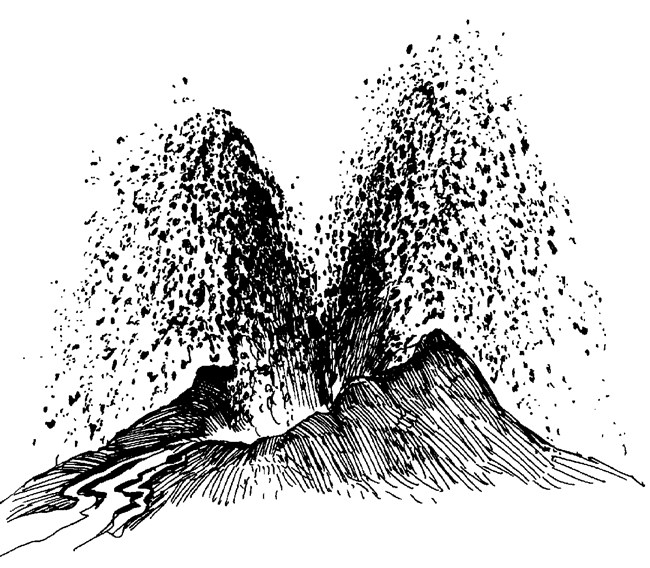
NPS Illustration What is Craters of the Moon Like?A Snickers BarThe earth's crust in the Craters of the Moon area is being pulled apart and thinned by forces within the earth. It is much like a Snickers Bar which you bend or stretch between your hands. Like the chocolate coating on the candy bar, the surface of the earth develops cracks called faults. It is one of these faults which has allowed magma to rise to the surface at Craters of the Moon. A Pop BottleThe magma underground is full of dissolved gases, like soda in a bottle of pop. It is dissolved gases that make a soda fizzy. We all know what happens when you shake up a bottle of pop and then take the top off. Volcanoes work the same way. The dissolved gases start to expand. Pressure builds and the volcano blows its top and erupts to release the pressure of the expanding gas. Old FaithfulLava erupted here in huge "fountains of fire." These fountains resembled the famous geyser Old Faithful but, instead of steam and water, they erupted melted rock. Puffed Rice and Root BeerThe lava in a "fountain of fire" eruption is very frothy, like foam on a glass of root beer. The frothy bits of lava shower the ground and build up large cones of cinders. The cinders are light weight and contain many air bubbles, like puffed rice cereal. Hollywood RocksThe light weight cinder rocks are like the foam rubber rocks that bounce down on cowboys in Hollywood westerns. Maple SyrupThe lava that poured from the ground to form the many lava flows at Craters of the Moon was thin and watery, like maple syrup. In contrast, the lava associated with the eruption of Mount St. Helens in Washington was thick and sticky, like peanut butter. ToothpasteLava in a fissure eruption oozes out of the ground like toothpaste being squeezed from a tube, and spreads out across the landscape like a river overflowing its banks. A Frozen RiverWhen a lava flow begins to cool, a crust forms on the surface which insulates the hot lava flowing beneath it. It's like the layer of ice that forms on a river in winter, with the water underneath it continuing to flow. A Hot Apple PieThe hot, sticky lava beneath a hardened crust is also like an apple pie. A Garden HoseLava flows beneath the solid crust of a lava flow like water through a garden hose. When the eruption stops, the lava drains out of the tube and leaves behind an empty chamber or cave. Cow PattiesSpatter Cones form as blobs of sticky lava pile up around a volcanic vent. The squashy blobs of lava resemble something you might find in a cow pasture! An Ice ChestThe lava rock is full of holes, like a hunk of Swiss cheese. These holes make the lava an extremely good insulator, like a giant styrofoam ice chest. The lava keeps the caves and spatter cones cool and preserves the ice that accumulates there in winter. A Rusty NailThe red color you see in some of the rock results from the same process that occurs when you leave your bicycle out in the rain. The iron in the rock rusts when it comes in contact with air and water. A MarriageThe colorful patches on the rocks are a plant called lichens. They are composed of two separate living things growing together in a way that benefits both: fungus and algae. Fred Fungus and Alice Algae took a "lichen" to each other. They got married, but unfortunately their marriage has been on the rocks ever since. A ParadeThe plants growing on the lava change through time. This process is like a Parade. The lichens come first, followed by small plants and shrubs, then limber pines, and finally sagebrush and grasses. |
Last updated: March 18, 2022
